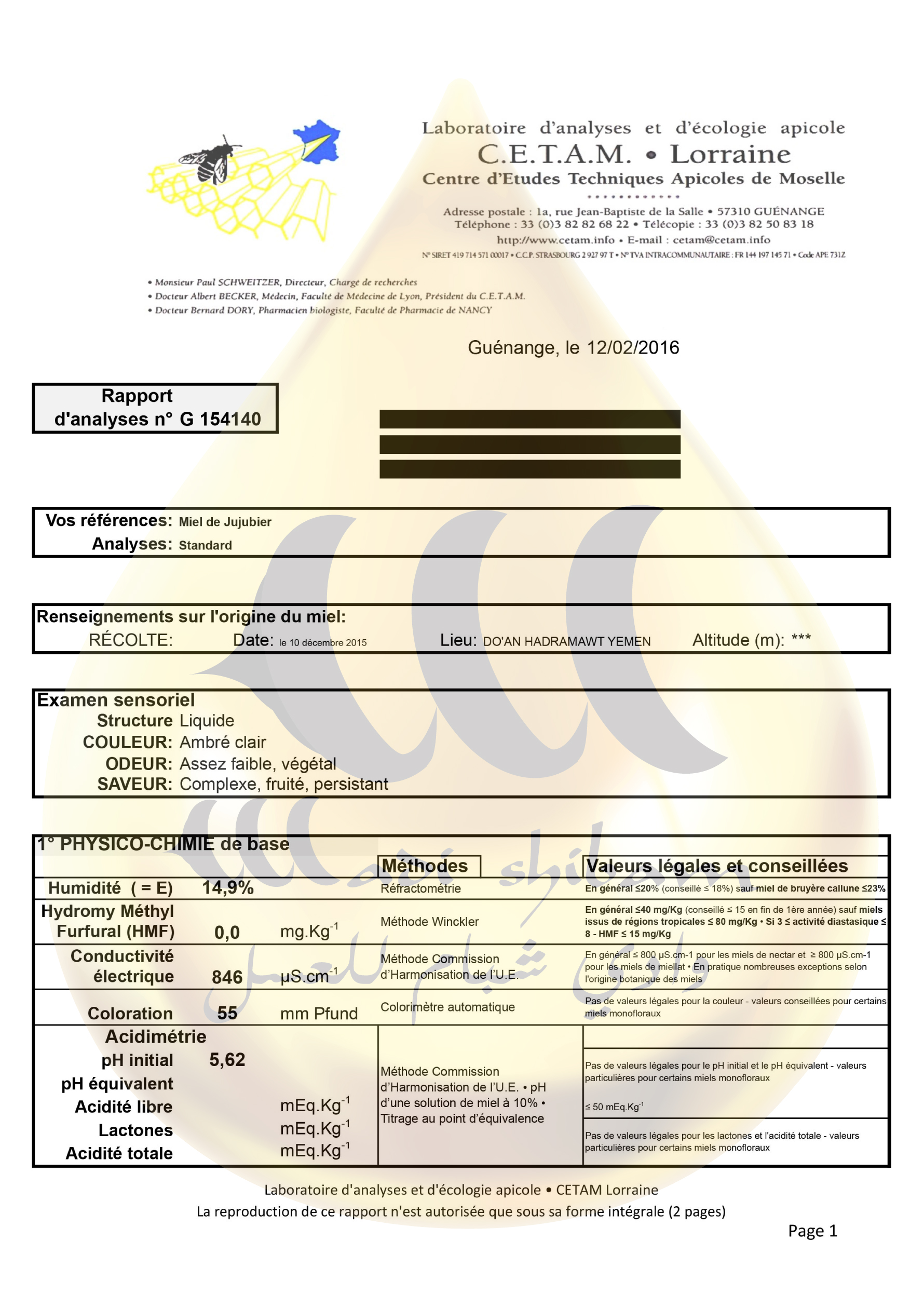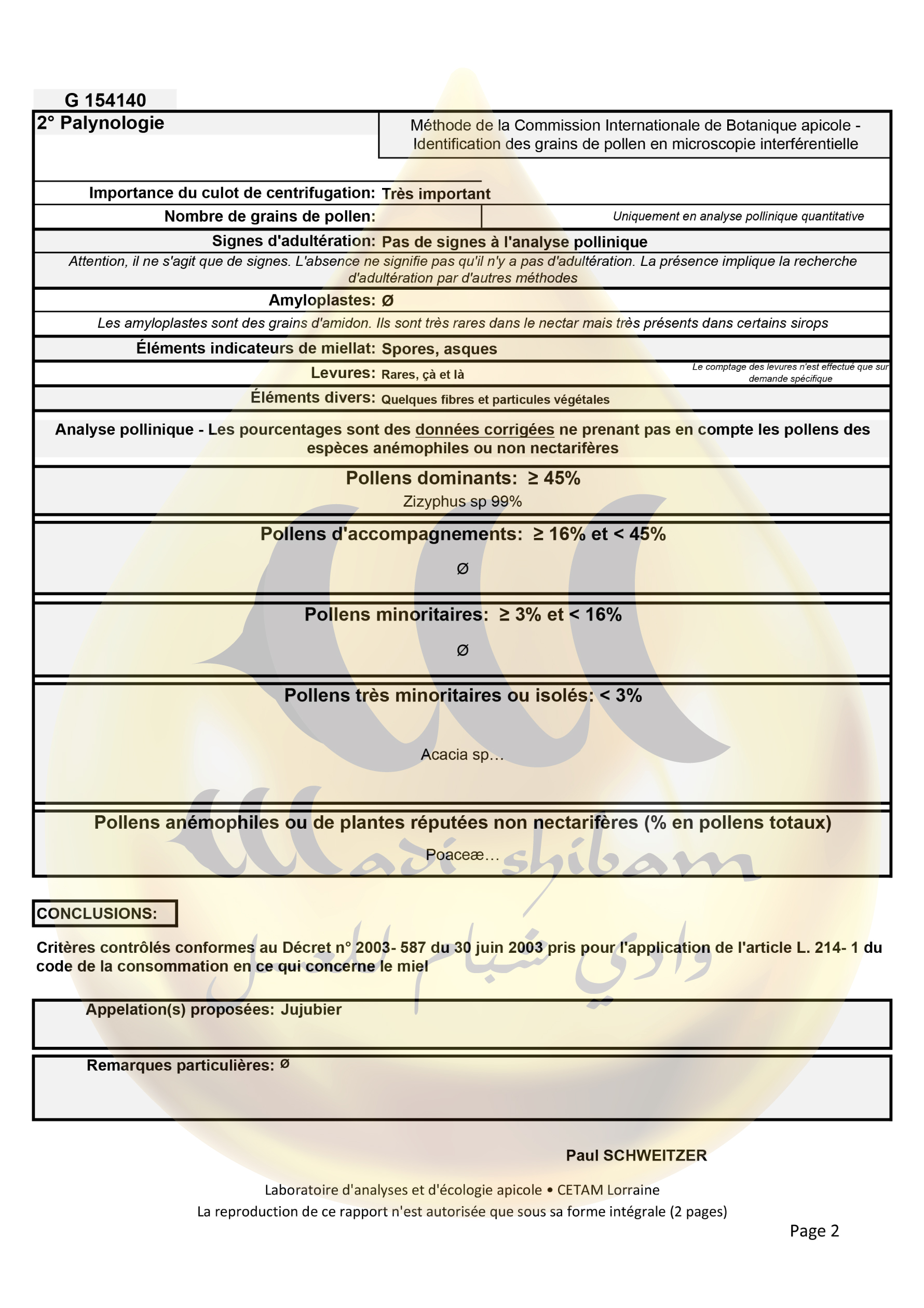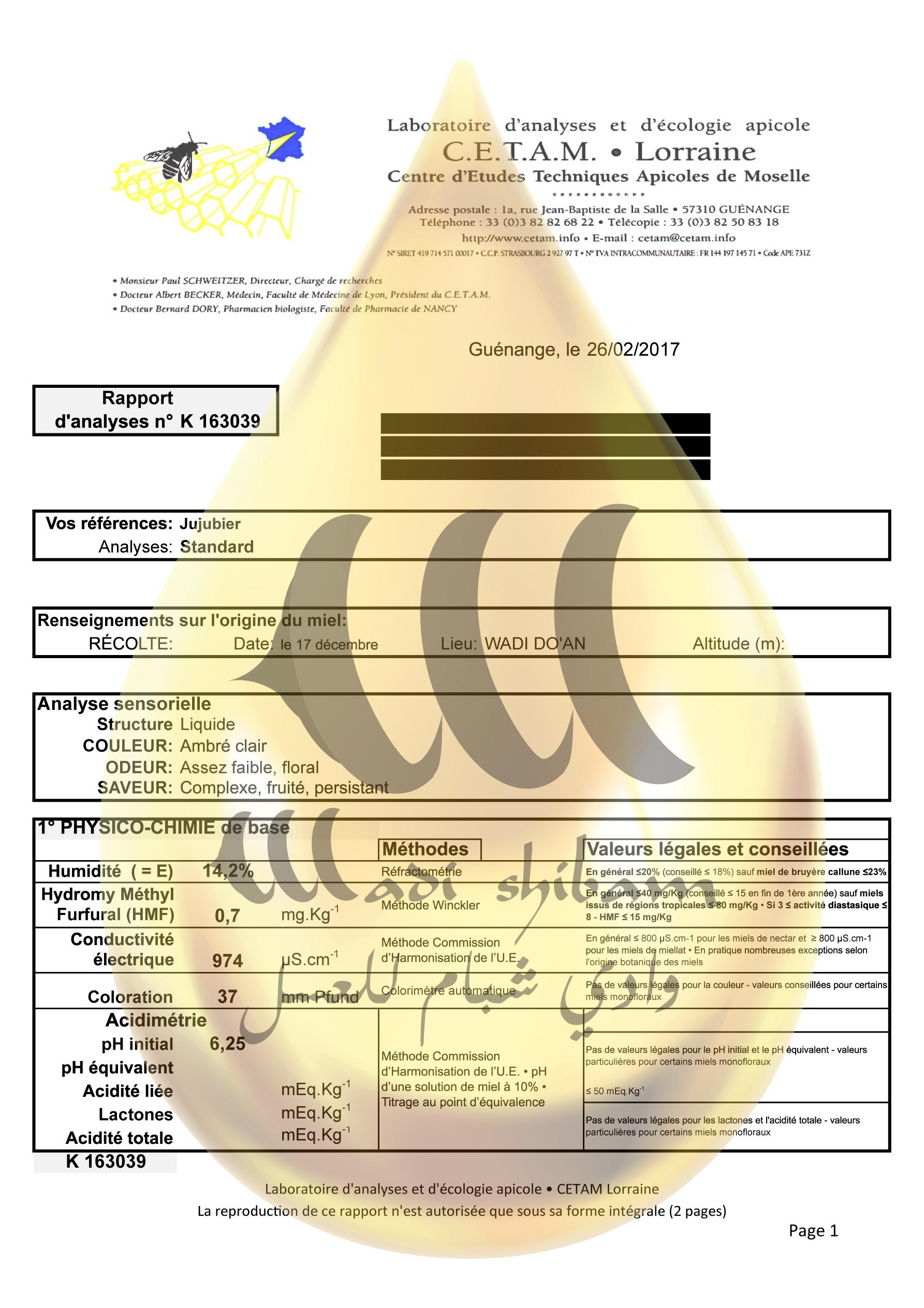 |  |
 |  |
These explanatory comments will be of great help to facilitate understanding of these different analyses for among other know what may be the criteria that determine whether a honey's jujube tree and how determine that honey can be of high quality knowing that the criteria for the name Ziziphus differ from those determining what a honey is high quality...
After having received the interpretation of the test laboratory which carried out various analyzes report, we contacted the director of the Laboratory of CETAM, Paul Schweitzer, who confirmed the correctness of this interpretation.
So we will discuss in this review the different explanations of these professionals.
We begin with the subject of the name "jujube"
Question:
When pollen analysis, there he has a minimum amount required for this honey has the "jujube" appellation. Also, what is the meaning or interpretation of the results of pollen analysis? For example, if we find 35% of pollen jujube or 85%, y there is a difference in the name of honey AND in terms of quality?
Paul's answer SCHWEITZER (laboratory director CETAM)
Whatever honey, there is no method to determine the precise botanical origin. The only thing we can do is confirm monoflorality a honey that does not mean it is 100% monofloral but it is enough to have the name. This is both a physicochemical sensory analysis, and pollen that can give or not the label. It has nothing to do with quality. A Honey said "monofloral" is never 100%.
Question:
Could you tell us what are the criteria required for that honey has the "honey jujube" appellation?
answer:
It must be the following analyzes:
For the label "jujube" qualitative pollen, sugar, electrical conductivity and acidimetry.
Unquote
The pollen analysis can identify plant species that have contributed to the development of honey , however this analysis alone does not allow to determine the oral name because some honeys contain very few grains pollen . This is the case of honey of acacia or lavender . Conversely , pollen from chestnut are themselves ubiquitous but beware, as pollen is very volatile since can find at 1000 meters above sea level , its presence in honey even dominant pollen does not imply any way that the harvested honey is a chestnut honey . Indeed, only an organoleptic test to determine the name.
We find ourselves in an article by Paul SCHWEITZER the following quotes :
" In beekeeping as often elsewhere , some myths die hard . In the field of analysis of honey, it is a myth that must absolutely break down is that of a close link between a pollen analysis and floral composition of honey. This belief , maintained even by some scientists, like anything there is a direct relationship between the pollen profile of honey , with or without weights , is a calamity for laboratories. Not only a pollen analysis is most often a very distant relationship with the floral origin honey , but there is currently no way to know the precise origin floral ! " * *
" The honey pine a large monospecific purity confirmed by the physical chemistry of sensory analysis sometimes contain 90% of oilseed rape pollen and lots of lavender honey contains mostly chestnut pollen ! the extraction of the lower part containing pollen balls introduce large amounts of pollen in the honey . in many areas where canola is grown , some honeys black locust a high purity confirmed monoflorale by physico-chemistry (profile of sugars in particular) can sometimes contain more than 80% of oilseed rape pollen when they contain , in reality , no rape honey at all. And I will mention here that memory techniques traditional extractions still frequently used in sub-Saharan Africa, for example where some honeys contain much pollen honey . pollen analysis is then meaningless. with this theory coefficients could be calculated in the same way floristic composition of royal jelly as this jelly contains pollen, which proves that in the hive , pollen is everywhere ! "
" When in a lavender honey 90% of chestnut pollen or honey pine 80% rapeseed applying coefficients will give significant results in rape honey or chestnut in the tree or lavender when there are zero. "
" A pollen analysis is made to determine the composition of honey. This is a" pollen fingerprint " of the hive which gives a certain extent , information on the botanical and geographical origin of honey but also on the work of the beekeeper. Such information is always interpreted with great caution . the pollen analysis used for the purpose of seeking a geographical origin is a very difficult science in the current context of globalization and global warming is constantly evolving and requires a permanent documentation. Used in order to give a name to a honey, this is one factor among others ( physico- chemical, sensory ) and this is of Besides not always the most important. in the Concours Général Agricole , no pollen analysis is requested for honey flowers, forest , chestnut , lavender, " acacia " ... The sensory analysis and control of certain physico- chemical elements are sufficient. In the field of flower names, we also prefer more and more to explore other avenues , certainly more efficient , as principal component analysis (PCA) based on the physico- chemistry associated with powerful mathematical tools and computer or even the near-infrared spectrophotometry (Near infrared ), the results are promising. This question takes us to those of mono-floral appellations which is a much more complex problem that is believed . "
Source:
http://www.apiservices.com/abeille-de-france/articles/appellation_monoflorale.htm
So Now for the criteria for determining the quality of honey
Question:
How , using analysis , can we know if honey is of high quality or not?
Paul's answer SCHWEITZER :
For quality : moisture , HMF and diastase activity .
Quality honey is free from pollution , has a lower moisture 18% , less than 20 HMF , a diastatic activity than 8 .
Unquote
In view of the results of analyzes, we realized that the analysis of the diastatic activity had not been made. So we questioned the laboratory that performed these analyzes told us that our index saccharase was high ( which is normal ) and therefore it does not require to analyze the diastase . Indeed , this is achieved if the index sucrase is below 10 .
Then, as regards the quality of the honey, the percentage of humidity is 13.9%, it is a very dry honey , we judge its viscosity . Also , there is less of sucrose and water ( moisture content ) in the honey it will keep more long without it crystallizes. In this case the rate of sucrose amounts to only 0.11 % ! Recognizing also that glucose is 25 % and that of fructose is 46% , it may be suitable for people with diabetes , fructose is an asset for diabetics and athletes because fructose glucose rises slightly during digestion .
However, it is obvious that it is consumed without excess ( after several attempts, we found that two teaspoons morning fasting have caused no increase in blood sugar and that from four rate glucose increased without being maddening ) .
For the result of HMF , is so small that it proves almost undetectable. Indeed, below 1.2 mg / kg it is very difficult to detect but it proves the freshness of honey, it was not heated and it has been harvested recently.
The HMF is a good indicator of the quality of honey . Indeed, the greater the number , the less honey will quality and conservation will be poor. A high rate can be assumed that honey has undergone a heating or has been harvested in poor condition and often for more than one year.
In conclusion, the laboratory that conducted the analyzes did we know that the percentage of pollen jujube can indeed influence the amount of nectar present in jujube honey. However, this is not a complete setting. This is the complete analysis , especially organoleptic tasting that will decide the quality of honey , as monofloral appearance or just dominance.
This fully confirms the explanation of Paul Schweitzer laboratory director CETAM .
And for the sample tested , they could say that this honey is very good quality, and has a strong monofloral appearance!
And we could rated this honey as a very very high quality . **
Good tasting ...

